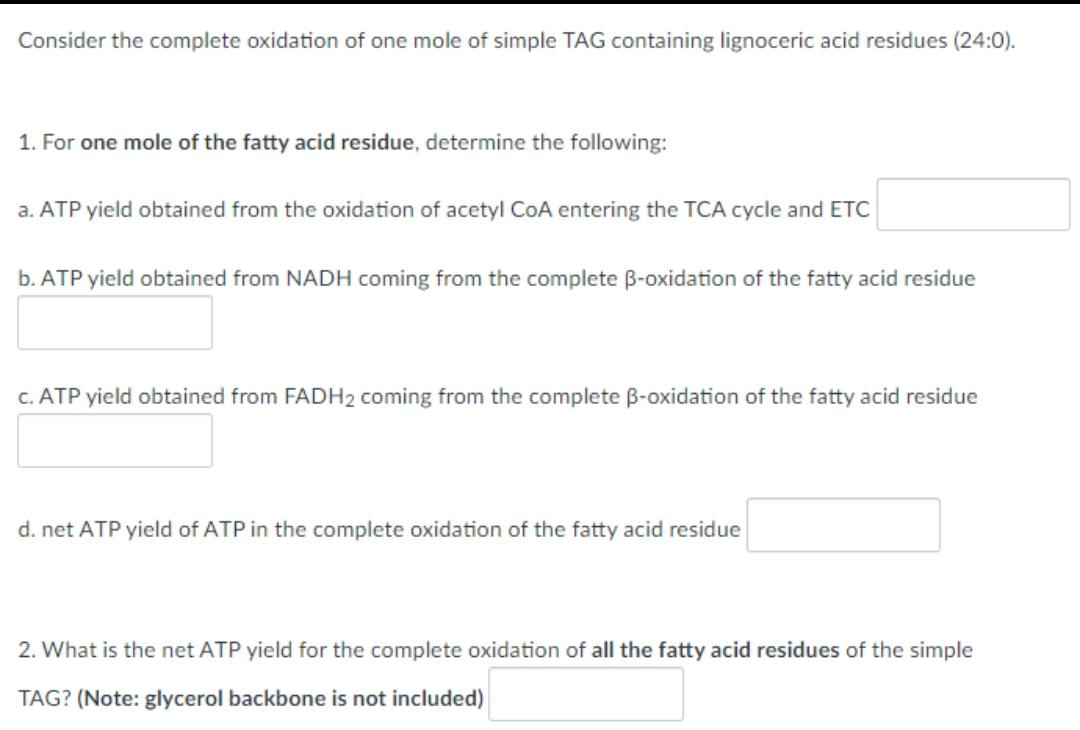Consider the complete oxidation of one mole of simple TAG containing lignoceric acid residues (24:0). 1. For one mole of the fatty acid residue, determine the following: a. ATP yield obtained from the oxidation of acetyl CoA entering the TCA cycle and ETC b. ATP yield obtained from NADH coming from the complete B-oxidation of the fatty acid residue c. ATP yield obtained from FADH₂ coming from the complete ß-oxidation of the fatty acid residue d. net ATP yield of ATP in the complete oxidation of the fatty acid residue 2. What is the net ATP yield for the complete oxidation of all the fatty acid residues of the simple TAG? (Note: glycerol backbone is not included)
Consider the complete oxidation of one mole of simple TAG containing lignoceric acid residues (24:0). 1. For one mole of the fatty acid residue, determine the following: a. ATP yield obtained from the oxidation of acetyl CoA entering the TCA cycle and ETC b. ATP yield obtained from NADH coming from the complete B-oxidation of the fatty acid residue c. ATP yield obtained from FADH₂ coming from the complete ß-oxidation of the fatty acid residue d. net ATP yield of ATP in the complete oxidation of the fatty acid residue 2. What is the net ATP yield for the complete oxidation of all the fatty acid residues of the simple TAG? (Note: glycerol backbone is not included)
Biochemistry
6th Edition
ISBN:9781305577206
Author:Reginald H. Garrett, Charles M. Grisham
Publisher:Reginald H. Garrett, Charles M. Grisham
Chapter19: The Tricarboxylic Acid Cycle
Section: Chapter Questions
Problem 21P: Complete oxidation of a 16-carbon fatty acid can yield 129 molecules of ATP Study Figure 19.2 and...
Related questions
Question

Transcribed Image Text:Consider the complete oxidation of one mole of simple TAG containing lignoceric acid residues (24:0).
1. For one mole of the fatty acid residue, determine the following:
a. ATP yield obtained from the oxidation of acetyl CoA entering the TCA cycle and ETC
b. ATP yield obtained from NADH coming from the complete B-oxidation of the fatty acid residue
c. ATP yield obtained from FADH₂ coming from the complete B-oxidation of the fatty acid residue
d. net ATP yield of ATP in the complete oxidation of the fatty acid residue
2. What is the net ATP yield for the complete oxidation of all the fatty acid residues of the simple
TAG? (Note: glycerol backbone is not included)
Expert Solution
This question has been solved!
Explore an expertly crafted, step-by-step solution for a thorough understanding of key concepts.
Step by step
Solved in 2 steps with 1 images

Recommended textbooks for you

Biochemistry
Biochemistry
ISBN:
9781305577206
Author:
Reginald H. Garrett, Charles M. Grisham
Publisher:
Cengage Learning

Biochemistry
Biochemistry
ISBN:
9781305577206
Author:
Reginald H. Garrett, Charles M. Grisham
Publisher:
Cengage Learning